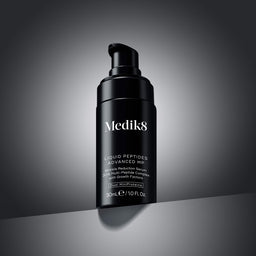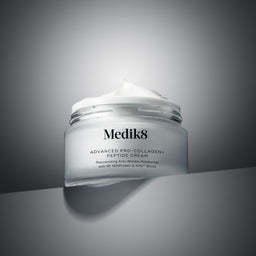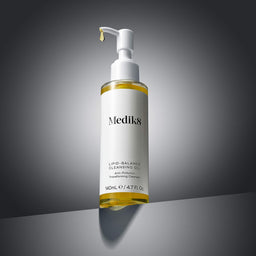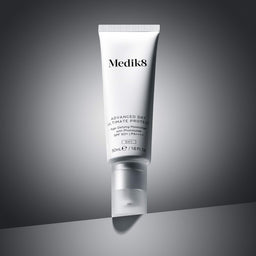Does toothpaste really help to clear blemishes? Is it true that chocolate causes spots? With so many myths floating around online, it can seem like an absolute mission to sort the false from the truth. But Medik8 is here to help. We’ve gathered up our team of skincare experts to dispel some of the biggest myths surrounding blemishes once and for all.
Does the sun help to clear up blemishes?
Many people believe that their skin improves when they are on holiday, but according to the experts going out in the sun should never be seen a quick-fix for your blemish concerns. “People notice skin improvements when they are in the sunshine because the sun’s UV rays suppress your immune system, and consequently your body’s reaction to blemish infections,” says Natalie Archer, Medik8’s Education Manager. “This means less redness and inflammation in the short-term, but it’s only temporary. Once you get back to your normal climate, your immune system will kick back in and your blemishes will return.”
What’s more, the sun can actually dry out the skin. This may feel gratifying at first, but it can send the sebaceous glands into overdrive; leaving your skin oiler and more problematic than it was before. Not to mention, sun exposure can worsen the look of post-inflammatory hyperpigmentation (the dark marks left behind after a blemish has healed), leaving your complexion dull and uneven. Then there’s the skin ageing factor to consider. UV light causes free radical damage to the skin, which destroys collagen and elastin; leading to fine lines and wrinkles.
Can toothpaste double-up as an overnight blemish cure?
“Toothpaste is often thought of as a quick, inexpensive treatment for blemishes. This is because it is packed with drying ingredients such as baking soda, hydrogen peroxide, alcohol, menthol and triclosan,” explains Daniel Isaacs, Medik8’s Formulation and Development Director. But this drying effect does not come without a cost: “Such ingredients are not designed to be used on the skin, which means they can cause irritation, inflammation, redness and peeling,” says Daniel – the last thing you want when trying to tackle problem skin.“ Oftentimes, blemishes will only appear smaller because the skin around them has become sore and irritated, so you’re actually doing more harm than good by applying toothpaste to your breakouts.” Those with sensitive skin should be even more wary as applying toothpaste to blemishes can cause severe over-drying and burns on delicate skin. Instead, Daniel suggests looking out for the following tried-and-tested ingredients:
Salicylic acid – This beta hydroxy acid (BHA) deeply penetrates the skin to dissolve dead skin cells and sebum from the inside of the pore as well as the surface of the skin.
Niacinamide – A moisturising active with anti-inflammatory properties to help reduce irritation and the appearance of redness and scarring.
L-Mandelic acid – An antibacterial alpha hydroxy acid (AHA) that exfoliates the surface of the skin to stop pores from becoming congested.
Probiotics – Live bacteria that strengthens the skin’s microbiome by boosting levels of good bacteria while decreasing blemish-causing bacteria.
Will chocolate give you spots?
“There is no scientific evidence that chocolate can cause spots, but we do know that a high-sugar/high-fat diet can increase sebum production and promote inflammatory responses in the body,” says Daniel. “In some individuals, dairy and sugar can trigger hormonal changes that contribute to inflammation. This worsens the appearance of breakouts.”
There are many reasons why this myth is so popular. Many women tend to indulge during the premenstrual part of their cycle. At this point estrogen levels have started to drop, which signals androgens to stimulate sebaceous glands, pumping up oil production. So it might actually be your hormones causing your breakouts rather than the chocolate that you’re craving. Similarly, when people are filling up on chocolate and other high-fat/high-sugar foods they tend to neglect other healthy nutritious foods. In this case, it may be a lack of proper nutrition contributing to the problem rather than the chocolate itself.
Does picking at the skin make blemishes worse?
Squeezing a blemish incorrectly can cause serious damage to your skin. Both permanent scarring and post-inflammatory hyperpigmentation can arise as a result of improper picking. But contrary to what you might have been told, squeezing a spot isn’t necessarily always a bad move. There are some key rules to bear in mind, however: “Never try to pick at any type of under-the-skin blemish. These kind of extractions usually require the use of specialist tools and are best left to the professionals”, says Natalie. “You should also wait until your pimple has a firm white head. This means the infection is close to the surface and is ready to be drained.”
1 To prepare, cleanse your face thoroughly with an exfoliating cleanser such as Clarifying Foam™. If possible, try to do this in the shower. The steam will loosen the sebum while the scrub removes dead skin cells to make extractions easier.
2 Wrap a soft tissue around your index fingers and place either side of the blemish, pushing your fingers together VERY gently.
3 After the extraction comes out cleanse the area again to get rid of any lingering bacteria. If nothing comes out after trying two to three times, don’t force it. You can try again in a few days, when the imperfection has come closer to the surface.
Will touching your face lead to breakouts?
Strictly speaking, touching your face doesn’t cause blemishes. But it can make it worse if you are already prone. Blemish-causing bacteria (P. acnes) is always present on the skin – even for those with clear complexions. So if you’re constantly touching your face, you can move the bacteria around, causing your blemishes to become more widespread.
It’s also worth pointing out that everyday bacteria (from door handles and keyboards etc) does not contribute to problem skin. Blemishes are caused by specific strains of bacteria that live on everybody’s skin, not by general dirt. So the perception that people with acne are dirty is also wildly incorrect.
← Older Post Newer Post →






